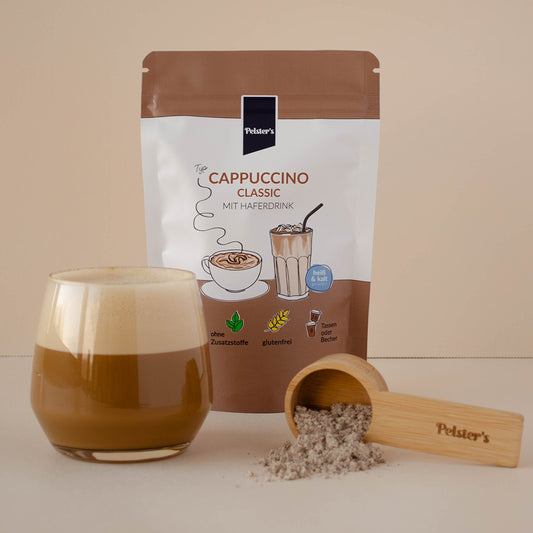In a world where nutritional trends are increasingly being discussed and questioned, oat milk is also increasingly coming into the spotlight as a plant-based milk alternative. While many people see it as a healthy alternative to cow's milk, the question remains: what effect does oat milk really have on blood sugar levels? Can consuming oat milk lead to dangerous blood sugar spikes, or is it - as is often claimed - a nutrient-rich option? In this article, we take a closer look at the glycemic properties of oats and oat milk.
Oats: A nutrient-rich whole grain
Oats, botanically known as Avena sativa , are one of the most nutrient-dense grains and offer numerous health benefits. In particular, the polysaccharide β-glucan, a soluble fiber, plays a key role in oats' health-promoting properties (8). One study shows that eating coarse oat flakes or whole oat kernels leads to a reduction in postprandial blood sugar levels, while finely ground oat products do not provide this effect to the same extent (6).
The reason for this lies in the processing: when oat grains are milled, the protective bran and germ layer is destroyed, which makes the starch easier to digest and more quickly converted into glucose. This effect reduces the glycemic advantage of oats (6).
The role of β-glucan
However, the β-glucan in oats slows down the digestion and breakdown of starch into glucose, resulting in a more moderate increase in blood sugar levels (6). According to the European Food Safety Authority (EFSA), about 4 g of β-glucan per 30 g of carbohydrates is sufficient to reduce glycemic responses after eating (7). Thus, β-glucan is not only known for its cholesterol-lowering properties, but is also associated with antidiabetic effects (8).
Glycemic Index and Glycemic Load
The glycemic index (GI) rates foods according to their ability to increase blood sugar levels. (1) The higher the GI, the faster the glucose enters the blood, which leads to a greater release of insulin. (4) However, the GI alone is only of limited use, as it does not take into account the influence of food composition. This is where the glycemic load (GL) comes into play, which links the GI to the carbohydrate content. Although oat drinks have a relatively high GI of 69, which is comparable to table sugar, their GL is only 3.5, which makes them a comparatively good option. (1,3) According to experts, the GL is therefore considered a more relevant parameter to reflect the triggered insulin requirement. (4)
Oat drinks and sugar: The facts
Oat drinks naturally contain sugar, which is released from the starch in oats during production. This starch is broken down into smaller sugar molecules, which can cause blood sugar levels to rise more quickly. However, despite a comparable GI to sugar, the low GL and high fiber content of oat drinks means that blood sugar levels rise more slowly (1, 4).
Holistic approach is crucial
When it comes to the influence of foods on blood sugar levels, not only the GI of a single food should be considered. (1) Many factors, such as fiber and fat content, degree of ripeness, preparation method and the overall composition of the meal, influence the blood sugar response. For example, one study shows that French fries and mashed potatoes have a higher GI than boiled potatoes, which is due to the processing temperature and liquid content. Due to physiological fluctuations, the GI of the same food can vary from person to person or even from day to day. Looking at individual foods is therefore misleading, since the composition of the entire meal in particular has an influence on the GI (3, 4).
Sugar as a scapegoat?
Although the body of healthy people is able to react to large amounts of sugar by releasing more insulin, this regulation is more difficult in people with diabetes. However, the development of type 2 diabetes is promoted by many other factors such as lack of exercise, obesity and lack of sleep. It is too simplistic to portray sugar alone as the main cause (1).
Conclusion: Context counts
In summary, oat drinks can affect blood sugar levels, but this is not necessarily negative. Rather, the glycemic load (GL), the overall diet and individual physiological differences are decisive in how our body reacts to sugar. Thanks to its low GL value and its fiber content, oat drinks have positive properties. It can therefore easily find a place in a balanced diet - as long as the overall picture of the diet is correct.
Sugar should not be seen as the sole scapegoat. A balanced diet and an active lifestyle are the best ways to stay healthy in the long term.
Sources
(1) Dankers, A., Kastilan, S. (2024). Oat milk, or the problem with sugar peaks. Welt. Online at: https://www.welt.de/gesundheit/article252302484/Ernaehrung-Hafermilch-oder-das-Problem-mit-den-Zuckerspitzen.html (last accessed: September 4, 2024).
(2) Atkinson, FS, Foster-Powell, K., & Brand-Miller, JC (2008). International tables of glycemic index and glycemic load values: 2008. Diabetes care , 31 (12), 2281-2283. à https://diabetesjournals.org/care/article/31/12/2281/24911/International-Tables-of-Glycemic-Index-and
(3) Jenkins, DJ, Wolever, TM, Taylor, RH, Barker, H., Fielden, H., Baldwin, JM, ... & Goff, DV (1981). Glycemic index of foods: a physiological basis for carbohydrate exchange. The American journal of clinical nutrition , 34 (3), 362-366.
(4) Consumer Center (2024). Glycemic Index (GI) and Glycemic Load (GL). Online at: https://www.verbraucherzentrale.de/wissen/lebensmittel/schlankheitsmittel-und-diaeten/glykaemischer-index-gi-und-glykaemische-last-gl-11176 (last accessed: September 4, 2024).
(5) Momenizadeh, A., Heidari, R., Sadeghi, M., Tabesh, F., Ekramzadeh, M., Haghighatian, Z., ... & Baseri, M. (2014). Effects of oat and wheat bread consumption on lipid profile, blood sugar, and endothelial function in hypercholesterolemic patients: a randomized controlled clinical trial. ARYA atherosclerosis , 10 (5), 259. at https://www.ncbi.nlm.nih.gov/pmc/articles/PMC4251477/
(6) Musa-Veloso, K., Noori, D., Venditti, C., Poon, T., Johnson, J., Harkness, LS, ... & Chu, Y. (2021). A systematic review and meta-analysis of randomized controlled trials on the effects of oats and oat processing on postprandial blood glucose and insulin responses. The Journal of nutrition , 151 (2), 341-351. à https://www.sciencedirect.com/science/article/pii/S002231662200044X
(7) EFSA Panel on Dietetic Products, Nutrition and Allergies (NDA). (2011). Scientific Opinion on the substantiation of health claims related to beta-glucans from oats and barley and maintenance of normal blood LDL-cholesterol concentrations (ID 1236, 1299), increase in satiety leading to a reduction in energy intake (ID 851, 852), reduction of post‐prandial glycaemic responses (ID 821, 824), and “digestive function” (ID 850) according to Article 13 (1) of Regulation (EC) No 1924/2006. EFSA journal , 9 (6), 2207. at https://efsa.onlinelibrary.wiley.com/doi/abs/10.2903/j.efsa.2011.2207
(8) Paudel, D., Dhungana, B., Caffe, M., & Krishnan, P. (2021). A review of health-beneficial properties of oats. Foods , 10 (11), 2591. at https://www.mdpi.com/2304-8158/10/11/2591



























На этом сайте АвиаЛавка (AviaLavka) вы можете забронировать выгодные авиабилеты по всему миру.
Мы подбираем лучшие тарифы от проверенных перевозчиков.
Простой интерфейс поможет быстро найти подходящий рейс.
https://www.avialavka.ru
Гибкая система поиска помогает выбрать оптимальные варианты перелетов.
Бронируйте билеты в пару кликов без переплат.
АвиаЛавка — ваш удобный помощник в поиске авиабилетов!
Здесь можно найти методы диагностики и советы по улучшению состояния.
1 2 3 4 5 6 7 8 9 10 11 12 13 14 15 16 17 18 19 20 21
Особое внимание уделяется психологическим особенностям и их связи с психическим здоровьем.
Также рассматриваются эффективные медикаментозные и психологические методы поддержки.
Материалы помогут лучше понять, как справляться с угнетенным состоянием в пожилом возрасте.
Центр ментального здоровья — это пространство, где каждый может найти поддержку и квалифицированную консультацию.
Специалисты работают с разными запросами, включая повышенную тревожность, эмоциональное выгорание и депрессивные состояния.
1 2 3 4 5 6 7 8 9 10 11 12 13 14 15 16 17 18 19 20 21
В центре используются современные методы терапии, направленные на улучшение внутренней гармонии.
Здесь создана безопасная атмосфера для доверительного диалога. Цель центра — поддержать каждого обратившегося на пути к психологическому здоровью.
Здесь можно узнать способы диагностики и подходы по улучшению состояния.
1 2 3 4 5 6 7 8 9 10 11 12 13 14 15 16 17 18 19 20 21
Особое внимание уделяется психологическим особенностям и их связи с психическим здоровьем.
Также рассматриваются эффективные терапевтические и психологические методы лечения.
Статьи помогут лучше понять, как справляться с угнетенным состоянием в пожилом возрасте.
На данном сайте АвиаЛавка (AviaLavka) вы можете забронировать выгодные авиабилеты в любые направления.
Мы предлагаем лучшие тарифы от проверенных перевозчиков.
Простой интерфейс поможет быстро найти подходящий рейс.
https://www.avialavka.ru
Интеллектуальный фильтр помогает подобрать самые дешевые варианты перелетов.
Бронируйте билеты в пару кликов без скрытых комиссий.
АвиаЛавка — ваш удобный помощник в путешествиях!